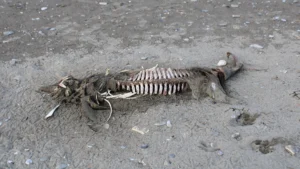As water levels receded Sunday, Sept. 18, residents in the Bering Strait region began taking stock of the damage done by the strongest fall storm to hit Western Alaska in fifty years. Sea berms were destroyed, homes were flooded or knocked off their foundations, and drinking water sources were contaminated.
In the community of Teller, the forecast from the National Weather Service had predicted all 230 plus residents would have their homes completely flooded during the storm. But Mayor Blanche Okbaok-Garnie said the community was prepared and a little bit lucky.
“We lost parts of our seawall. We lost quite a bit of the rocks that hold up the seawall and then we lost some of the planks, treated planks. But for the most part, … the homes were dry. Some of the water went up and around some of the homes and boats,” Okbaok-Garnie said.
Teller did still experience rising water levels from the three surrounding water sources, and some subsequent erosion. But Okbaok-Garnie says the damage was not nearly as bad as predicted. The mayor wants to acknowledge many volunteers in the community who assisted, including Nathan Topkok, Chad Pushruk, and Mack and Bebe Herrington.
Okbaok-Garnie also shared details on an ongoing supply shortage at the local store that Teller is facing. This has been going on for months she said due to a lack of staff to operate the community store, which has caused a shortage of food shipments. World Central Kitchen is planning to assist Teller and other Norton Sound communities by providing food relief this week.
Across the Norton Sound in Unalakleet, residents were evacuated the afternoon of Sept. 17 to the local school until the notice was lifted the morning of Sept. 18. Despite having high water and debris on the airport ramp, the local airport was operational as of Sept. 18.
The city office also reported a complete water pressure loss during the storm, along with power outages, which has led to a boil water notice and conserving of water until the city can reach their pump house.
There could be some temporary relief coming to Unalakleet and several other communities in the Norton Sound that are without potable water.
Northern Air Cargo, other freight carriers, and the National Guard would be delivering bottled water and supplies to communities without drinking water, Nome Mayor John Handeland said during the city emergency operations meeting on Sept. 18.
“NAC does have a couple freighters that are scheduled to come our way. Their first load sounds like it’s going to be bottled water that needs to get out into communities around our area. The biggest concern that I mentioned to the Governor and General Saxe is probably the food supply and getting the bypass mail and cargo going.”
The Red Cross is also planning to respond to Western Alaska and address various emergency needs this week.
In spite of rising water levels threatening the Nome airstrip over the weekend, there was no standing water on the runway or significant damage so flights resumed Sept. 18. Throughout the Nome area, water levels rose to about nine feet above the normal high tide line during the storm, according to Rick Thoman with the Alaska Center for Climate Assessment and Policy under UAF.
“We can say for sure, this was the highest storm surge for Nome since the great November, 1974 storm. This was about eight inches higher than the Bering Sea superstorm in 2011,” Thoman said.
With those rising water levels on Saturday, a house from Belmont Point was swept into the Snake River and trapped under the bridge. Mayor Handeland told the Nome Nugget that the home was unoccupied when it floated away.
City officials enlisted help from gold miner Sean Pomrenke to remove the house in sections and haul away the debris on Sept. 18 as one of their recovery tasks. The city’s other priorities include assisting about 15 local residents who evacuated from their homes. Seventeen people stayed at the Nome Recreation Center Sunday night, which was set up as the emergency shelter during the storm, City Manager Glenn Steckman said. That shelter is likely to be operational for the next few days.
Locally the cleanup process has already begun, with the State Dept. of Transportation, or DOT, coordinating to make Nome’s roads passable again. The agency will be assessing the damage to Nome-Council road which was significantly eroded in certain sections on the east end of town, according to DOT’s regional superintendent for the Western District Calvin Schaeffer.
“We’re trying to get a grader out toward the Cape (Nome) and then beyond that, assess damages and maybe take an engineer with him. Then we’re going to go from there and basically see what we can do to open it back up, and do what we can before winter,” Schaeffer said.
Based on social media posts, further down the road to the east, the Safety Sound bridge has been completely dislodged and is unusable at this time.
The Nome City Council is scheduled to meet at noon on Sept. 19 to make a formal disaster proclamation for this storm.
Image at top: Coastal flooding damages east Front Street in Nome on Sept. 17. Photo by Scotty Campbell, KNOM (2022).





